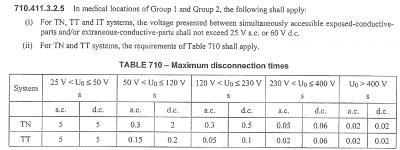IEC-60364-4-41 limits the conventional touch voltage to 25 volts during a fault, in addition to requiring a faster breaker opening time:

With breaker opening time not to exceed 0.3 seconds:

So how or why does this force redundant EGCs? Simple: ohms law
According to chapter 9 table 9, #12 conductor is 2 ohms per 1000 feet.
So, with a 200 foot run from a panel to a patient bed, the hot would have 0.4 ohms on the hot and 0.4 ohms on the EGC.
This would cause 150 amp of current to flow, opening a breaker in about 1 second worse case. So this governs clearing time.
Second, when a fault occurs a resistive divider is formed- 50% voltage drops across the hot 50% voltage across the EGC- so 60 volts to remote earth for up to 1 second.
Normally this would not be an issue according to the IEC body graph assuming 1000 ohms of body resistance.
However, in medical locations this values changes down to 400 ohms or lower.
Thus, a greater degree of protection is required.
So- now the same scenario with a metal raceway.
0.4 ohms on the hot
0.4 ohms on the combined copper EGC and 0.2 ohms on the conduit EGC whereby both create a parallel path down to 0.13 ohms.
The voltage division now changes whereby only 29 volts is present to remote earth.
Second, with the total ground fault loop impedance down to 0.53 ohms, the fault current increases now to 226 amps, making it likely the breaker will trip on its magnetic pickup (20x10=200).



